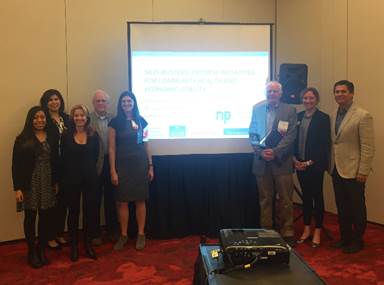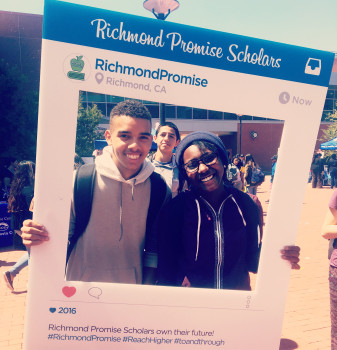|
| The Richmond Promise program is starting to attract a lot of attention, both locally and nationally.
A couple of weeks ago, Richmond Promise Executive Director Jessie Stewart and I presented, at the New Partners for Smart Growth Conference in Saint Louis along with Chancellor Oakley, and leaders of The Long Beach College Promise, The Kalamazoo Promise. We shared lessons learned, and the value of community-based investments in education! #toandthrough City of Richmond, CA Environmental and Health Initiatives West Contra Costa Schools Heads Up America Better Make Room Contra Costa College

Our panel at New Partners for Smart Growth
Next week, Jessie and I will again present at the National Achieving the Dream's Conference Friday, February 24th at the San Francisco Hilton Union Square, the day that the College Promise Campaign’s National Advisory Board will be in town.
Although other cities in California, including Oakland and San Francisco, have started Promise programs, Richmond has the largest committed funding of any program in California!
The story below appeared in today’s on-line version of the East Bay Times. It details some of the challenges of building a college-going culture, but it also indicates how important it is to start building that culture.
Every day, the Richmond Promise is expanding partnerships to make the program stronger and more attractive. We can announce that Contra Costa College just received the Promise Innovation grant that we jointly applied for last month. This will fund the Richmond Promise first year experience pathway!
Richmond: Program taking new steps to build a college going culture
Richmond Promise, a scholarship program, focusing on student support long before graduation

The Richmond Promise program, a $35 million fund that gives scholarship money to Richmond high school graduates, is struggling to attract students.
By Karina Ioffee | kioffee@bayareanewsgroup.com |
PUBLISHED: February 17, 2017 at 10:55 am | UPDATED: February 17, 2017 at 4:23 pm
RICHMOND — When the city announced that Chevron would pay $35 million to fund a college scholarship program for every high school graduate in the city, it was celebrated as a unique opportunity to help low-income students get a leg up without going deep in debt.
But a year after the Richmond Promise program was established, the reality of what it might take to get a high school graduate into college has proven more difficult to achieve. Of the 800 students eligible for the tuition assistance program, just 255 students — less than a third who could qualify– claimed the scholarship last year. This spring the numbers look better, with 427 applications started and 215 completed before the March 10 deadline.
There are many reasons students may not be applying. The scholarship — $1,500 a year for any junior college or four-year school — is considerably less than the full-paid tuition some thought they would be getting when the program was first introduced, and after private and charter schools lobbied to be included.
And there is a lot of pressure, especially among low-income students, to earn money, said Jessie Stewart, the executive director of Richmond Promise. As a result, many students may intend to start college, but drop out to work or switch to part-time studies, making them ineligible for the scholarship. Others struggle with the financial aid application and just give up when they can’t figure it out.
“We know that a scholarship in and of itself is not going to change systemic problems students have experienced in terms of continuing their educations,” Stewart said. “It’s a collective effort that begins early on, in pre-K and elementary, and includes a lot of wrap-around support to help students become college-ready.”
Last year, 33 percent of Richmond students who received the scholarship never ended up using it because they don’t show up for class, a phenomenon known as “summer melt.”
Related Articles
“Obviously, it’s got a ways to go before it can be as successful as we envisioned, but it’s an effort that requires all in our community to be involved in,” said Jael Myrick, a Richmond councilman who helped secure the $90 million community benefits agreement from Chevron that includes the college scholarship program, in exchange for approving the company’s $1 billion modernization project.
Myrick said he thought many students were procrastinating and would likely apply over the next several weeks.
To help boost participation, Richmond Promise has recently partnered with Contra Costa College to form a summer bridge program that includes a week-long math intensive, and advising and counseling courses to help students transition to college. Incoming college freshmen are also required to take career exploration and financial literacy classes, and develop an educational plan.
“Our goal is to build a sense of community for the scholars so that they aren’t lost when they get here,” said Vicki Ferguson, dean of student services at the college.
Richmond Promise also started a pilot program at Kennedy High School this year that brings recent high school graduates into classrooms to help freshmen understand the steps they need to take to get into a two-year or four-year school. It’s a steep climb. Last year, only 42 percent of district students completed courses required to get into the University of California or California State University system, lower than both the state and county average.
Aracely Gomez, 18, a Richmond resident who now attends San Francisco State University, is one of those mentors and said she wanted to get involved to help build a college-going culture among local students.
“I remember that when I was a freshman I didn’t know anything about college,” said Gomez, who, like most participants in the Richmond Promise, is the first in her family to attend university. “Seniors would graduate every year and just disappear and we didn’t know what happened to them.”
Guided by her own experience, she wants Richmond students to not only get a glimpse of what it takes to get into college, but also learn that there are many resources to help them get there — from tutoring to after-school programs and assistance with college applications.
“I don’t think most are aware of all the other services that come with the Promise,” Gomez said.
A year after its launch, the program has given out $327,000 in scholarships. It’s also an official nonprofit, meaning it can now focus on fundraising to extend the lifespan of the program. If no additional funds are raised, the money will run out in about a decade. |
|

